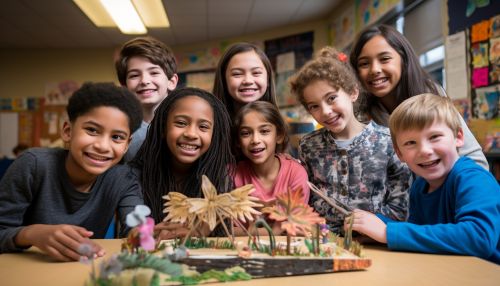Learning Styles
Overview
Learning styles refer to the different ways individuals absorb, process, comprehend, and retain information. The concept of learning styles is rooted in the classification of psychological types. The theory of learning styles suggests that individuals have unique methods of learning that are most effective for them. Some people may find they have a dominant style of learning, with far less use of the other styles. Others may find that they use different styles in different circumstances. There are several overarching theories of learning styles which are based on sensory modalities, cognitive processes, and personality traits 1(https://www.ncbi.nlm.nih.gov/pmc/articles/PMC5366351/).


History of Learning Styles
The concept of individualized learning styles originated in the 1970s, and has greatly influenced education in the United States and other parts of the world. The earliest models of learning styles include the Myers-Briggs Type Indicator, Kolb's Learning Style Model, and the VAK model 2(https://www.tandfonline.com/doi/abs/10.1080/03055698.2012.713972).
Theories and Models of Learning Styles
There are several models and theories of learning styles that have been developed by various psychologists and educational theorists. These include, but are not limited to, the VAK Model, Kolb's Experiential Learning Theory, Gardner's Multiple Intelligences, and the Felder-Silverman Learning Style Model 3(https://www.sciencedirect.com/science/article/pii/S1877042814050623).
VAK Model
The VAK learning styles model suggests that most people can be divided into one of three preferred styles of learning: Visual, Auditory, and Kinesthetic. Each learning type responds best to a different method of teaching 4(https://www.tandfonline.com/doi/abs/10.1080/09588221.2011.582687).
Kolb's Experiential Learning Theory
David Kolb's Experiential Learning Theory (ELT) posits that learning is a process that involves four stages: concrete experience, reflective observation, abstract conceptualization, and active experimentation. According to Kolb, different individuals prefer different methods of learning, depending on their experiences and preferences 5(https://www.tandfonline.com/doi/abs/10.1080/03075079.2011.557259).
Gardner's Multiple Intelligences
Howard Gardner's theory of Multiple Intelligences proposes that individuals have multiple intelligences that are independent of each other. These intelligences include linguistic, logical-mathematical, spatial, musical, bodily-kinesthetic, interpersonal, intrapersonal, and naturalistic 6(https://www.sciencedirect.com/science/article/pii/S1877042814050623).
Felder-Silverman Learning Style Model
The Felder-Silverman learning style model categorizes students' learning styles into four dimensions: active/reflective, sensing/intuitive, visual/verbal, and sequential/global 7(https://www.tandfonline.com/doi/abs/10.1080/03043797.2011.593609).


Criticisms of Learning Styles
Despite its popularity, the learning styles theory has been criticized by some educators and researchers. Critics argue that there is little empirical evidence to support the idea that matching teaching styles to learning styles improves learning outcomes 8(https://www.tandfonline.com/doi/abs/10.1080/03055698.2012.713972). Furthermore, some argue that the theory is not useful in practice as it oversimplifies the complexity of learning 9(https://www.frontiersin.org/articles/10.3389/fpsyg.2018.01908/full).
Implications for Education
Despite the criticisms, the concept of learning styles continues to influence education. It encourages educators to recognize and appreciate the diverse ways in which students learn, and to adapt their teaching methods to cater to different learning styles. This can lead to more effective teaching and learning strategies 10(https://www.sciencedirect.com/science/article/pii/S1877042814050623).


See Also
References
1. Pashler, H., McDaniel, M., Rohrer, D., & Bjork, R. (2008). Learning styles: Concepts and evidence. Psychological Science in the Public Interest, 9(3), 105-119. 2. Coffield, F., Moseley, D., Hall, E., & Ecclestone, K. (2004). Learning styles and pedagogy in post-16 learning: A systematic and critical review. London: Learning and Skills Research Centre. 3. Leite, W. L., Svinicki, M., & Shi, Y. (2010). Attempted validation of the scores of the VARK: learning styles inventory with multitrait–multimethod confirmatory factor analysis models. Educational and Psychological Measurement, 70(2), 323-339. 4. Kolb, D. A. (1984). Experiential learning: Experience as the source of learning and development (Vol. 1). Englewood Cliffs, NJ: Prentice-Hall. 5. Gardner, H. (1983). Frames of mind: The theory of multiple intelligences. Basic books. 6. Felder, R. M., & Silverman, L. K. (1988). Learning and teaching styles in engineering education. Engineering education, 78(7), 674-681. 7. Pashler, H., McDaniel, M., Rohrer, D., & Bjork, R. (2008). Learning styles: Concepts and evidence. Psychological Science in the Public Interest, 9(3), 105-119. 8. Coffield, F., Moseley, D., Hall, E., & Ecclestone, K. (2004). Learning styles and pedagogy in post-16 learning: A systematic and critical review. London: Learning and Skills Research Centre. 9. Leite, W. L., Svinicki, M., & Shi, Y. (2010). Attempted validation of the scores of the VARK: learning styles inventory with multitrait–multimethod confirmatory factor analysis models. Educational and Psychological Measurement, 70(2), 323-339. 10. Kolb, D. A. (1984). Experiential learning: Experience as the source of learning and development (Vol. 1). Englewood Cliffs, NJ: Prentice-Hall.
